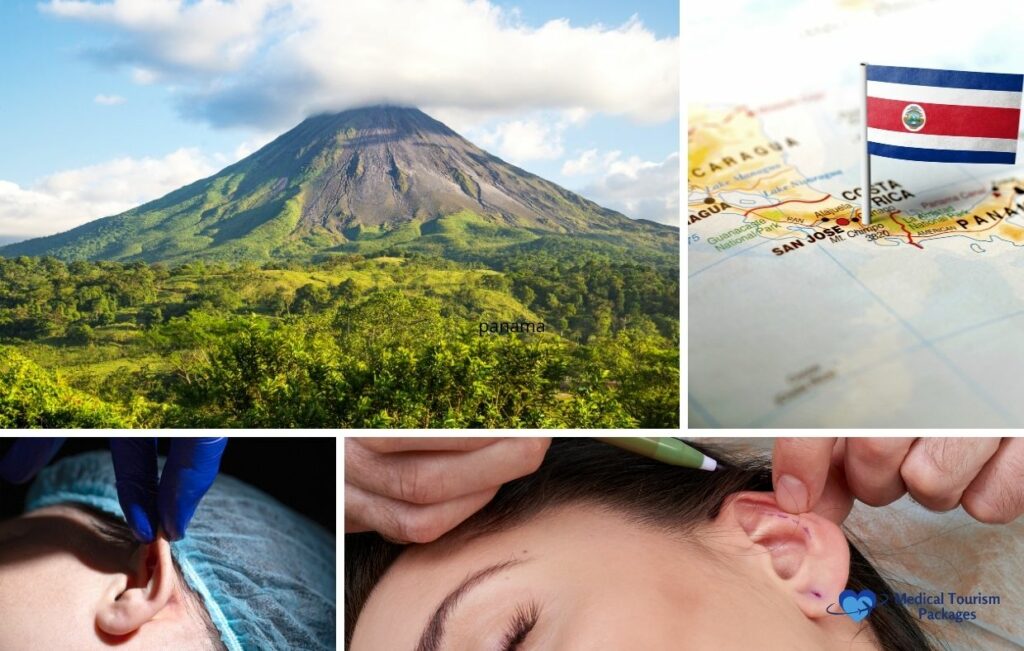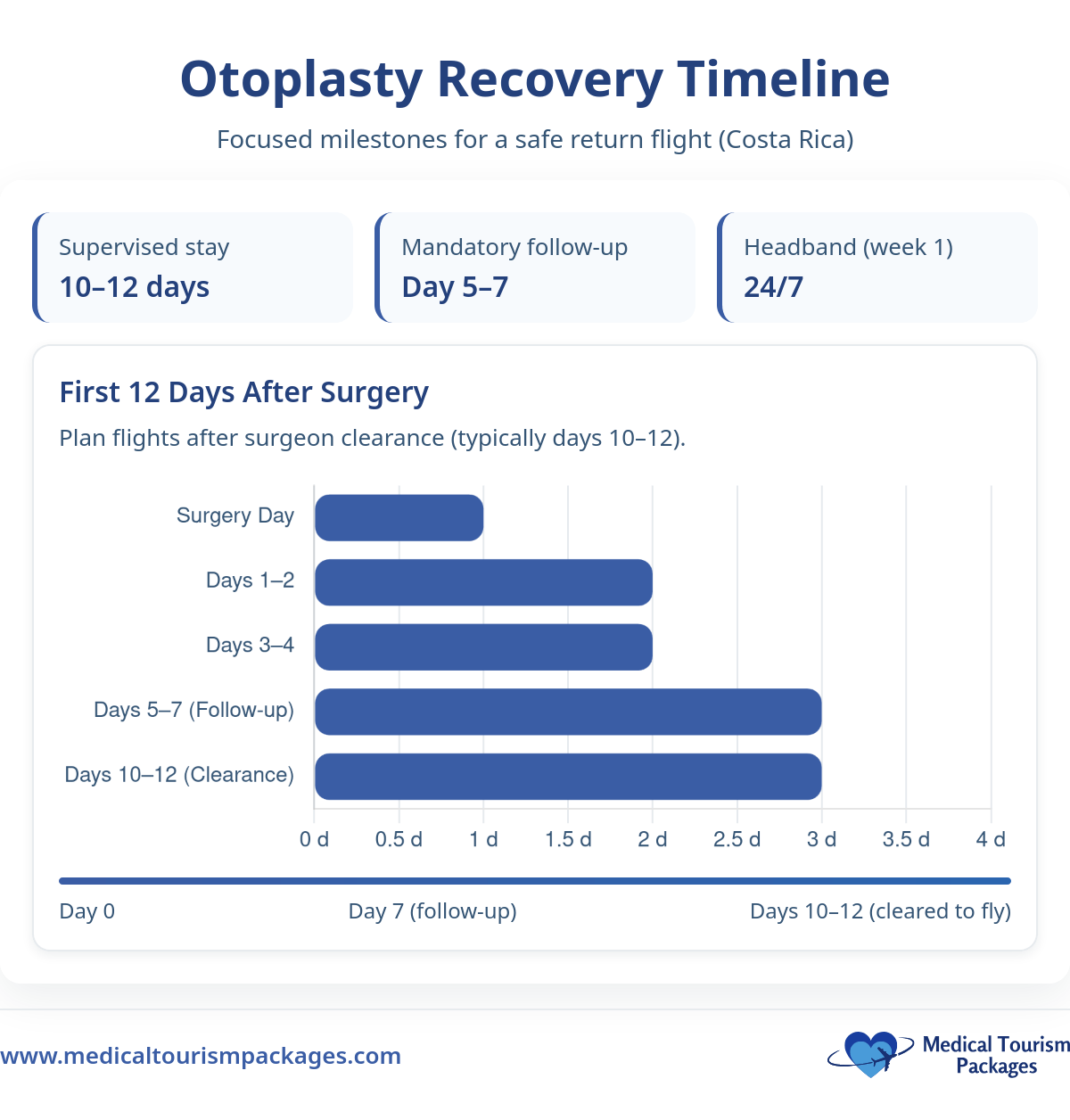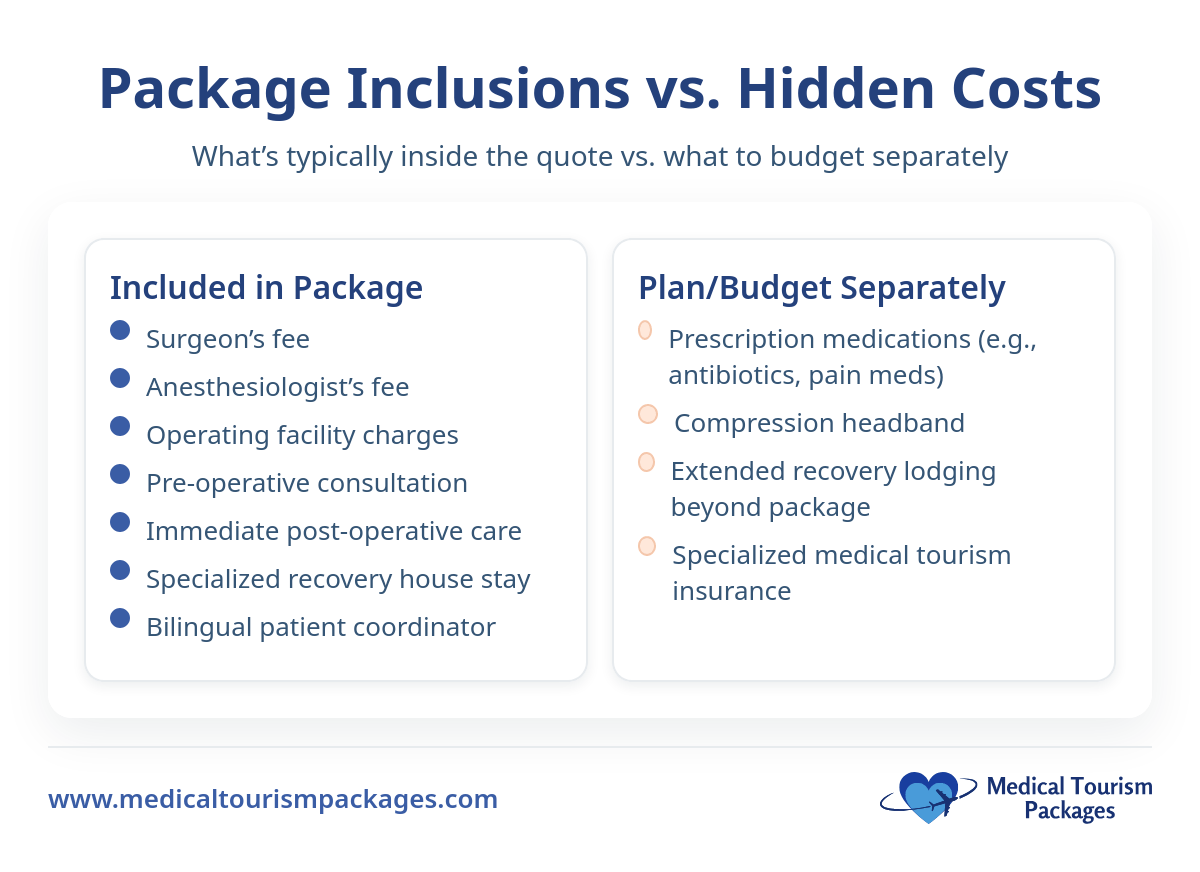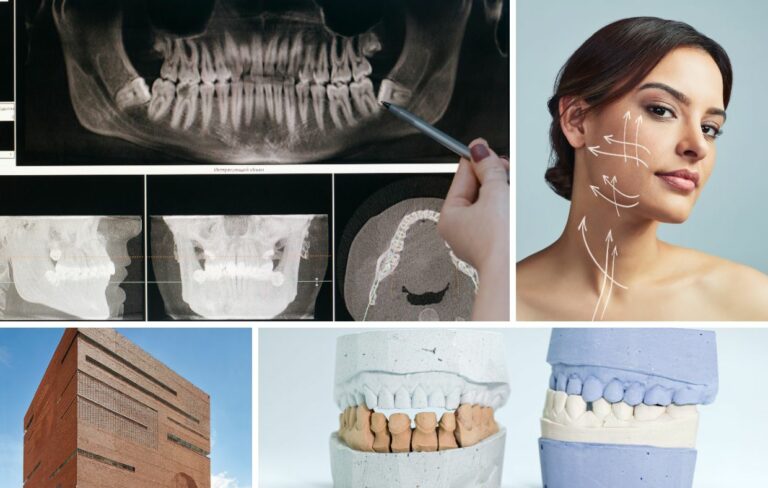Book Appointment Now

Otoplasty in Costa Rica: Costs, Surgery, Recovery, and Results
Considering ear surgery abroad? Costa Rica has emerged as a leading destination for otoplasty, combining experienced plastic surgeons with significant cost savings compared to the United States, Canada, and Europe.
Otoplasty, commonly called ear pinning or ear lift surgery, corrects protruding ears, reduces ear size, or improves ear symmetry. While this procedure is often performed on children, many adults seek otoplasty to address lifelong insecurities about their ear appearance.
Costa Rica offers several advantages for medical tourists. You’ll find board-certified plastic surgeons trained in top international programs, modern surgical facilities accredited by recognized organizations, and procedures that cost 50-70% less than in North America. The country’s proximity to the United States, stable healthcare infrastructure, and appeal as a recovery destination make it practical for combining surgery with recuperation.
This guide covers everything you need to know about getting otoplasty in Costa Rica. You’ll learn what the procedure involves, typical costs and what’s included, how to choose a qualified surgeon, what to expect during recovery, and how to plan your medical trip. Whether you’re exploring options for yourself or a family member, understanding these details helps you make an informed decision about pursuing ear surgery abroad.
What is Otoplasty Surgery in Costa Rica?
Otoplasty is a surgical procedure that reshapes, repositions, or reduces the size of the ears. Surgeons perform this cosmetic surgery to correct ears that protrude too far from the head, address asymmetry between ears, or repair deformities from injury or birth conditions.
The procedure is ambulatory, meaning you don’t stay overnight in the hospital. Surgery typically takes one to two hours under local anesthesia with sedation or general anesthesia. After a brief recovery period of about two hours in the facility, you return to your accommodation the same day.
Costa Rica has established itself as a premier medical tourism destination for cosmetic procedures. The country’s plastic surgeons commonly train at accredited institutions in the United States, Europe, and Latin America. Many hold certifications from international boards and maintain memberships in professional organizations like the International Society of Aesthetic Plastic Surgery (ISAPS).
Surgical facilities in Costa Rica’s major cities—particularly San José and Escazú—meet international accreditation standards. You’ll find hospitals and clinics certified by organizations such as Accreditation Canada International or the Joint Commission International. These facilities use modern equipment and follow sterilization protocols comparable to those in North American and European medical centers.
The combination of qualified surgeons, accredited facilities, and substantial cost savings has made Costa Rica a trusted choice for patients seeking otoplasty abroad. The country performs thousands of cosmetic procedures annually for international patients, with ear surgery being among the common requests.
What are the Benefits of Undergoing Otoplasty in Costa Rica?
Otoplasty delivers both aesthetic and psychological benefits that extend beyond simple appearance changes. Understanding these advantages helps you evaluate whether the procedure aligns with your goals.
Aesthetic Improvements
The surgery addresses several ear concerns through specific techniques. Ear pinning brings protruding ears closer to the head by repositioning cartilage and removing excess tissue. This creates a more balanced profile and reduces the prominence that many patients find bothersome.
Cartilage reshaping refines the ear’s contours and folds. Surgeons sculpt the antihelix—the inner curved fold of the ear—to create definition that may be missing or underdeveloped. This technique improves the ear’s natural appearance without looking artificial.
Conchal bowl reduction decreases the size of the cup-shaped cavity near the ear canal. When this area is too deep or large, it pushes the entire ear outward. Removing a small section of cartilage allows the ear to sit flatter against the head.
These corrections improve facial symmetry and proportion. Most patients report increased confidence in wearing hairstyles that expose their ears, including ponytails, short cuts, or slicked-back styles.
Functional and Psychological Benefits
Beyond appearance, otoplasty can improve quality of life. Children and adults who felt self-conscious about their ears often experience reduced anxiety in social situations. The procedure eliminates a common source of teasing or unwanted attention.
Some patients find practical benefits. Glasses fit more comfortably, and headwear sits properly without ears pushing forward. While otoplasty doesn’t improve hearing, correcting structural deformities can enhance how hearing aids or headphones fit.
Costa Rica’s Added Value
Choosing Costa Rica for otoplasty means accessing these benefits at significantly lower costs. You receive the same surgical techniques and outcomes available in your home country while saving money that can cover travel expenses, extended recovery time, or other priorities. The country’s infrastructure supports safe medical tourism with English-speaking staff, straightforward coordination, and comfortable recovery accommodations near surgical facilities.
How Much Does Otoplasty Cost in Costa Rica?
Otoplasty in Costa Rica typically costs between $1,800 and $2,500 USD. This represents a 65-75% savings compared to prices in the United States, Canada, and many European countries.
These lower costs don’t reflect inferior quality. Costa Rica’s overhead expenses—including facility maintenance, staff salaries, and operational costs—are significantly lower than in North America. Surgeons maintain competitive international pricing while delivering comparable surgical outcomes.
Comparative Otoplasty Costs by International Region
| Region/Country | Average Cost (USD) | Cost Range (USD) |
| Costa Rica | $2,150 | $1,800 – $2,500 |
| United States | $6,500 | $4,000 – $10,000 |
| Canada | $5,800 | $4,500 – $8,500 |
| United Kingdom | $5,200 | $3,800 – $7,000 |
| Australia | $6,000 | $4,500 – $8,500 |
| Mexico | $2,400 | $1,900 – $3,200 |
| Colombia | $2,200 | $1,700 – $3,000 |
Cost Factors
Several variables influence your final price:
- Complexity of surgical technique – Bilateral otoplasty (both ears) costs more than unilateral procedures. Extensive cartilage reshaping or reconstruction requires additional surgical time.
- Less complex procedures may be quoted separately – Minor adjustments or revision surgery may fall at the lower end of the price range.
- Premium pricing factors – JCI-accredited facilities, surgeons with advanced international training, comprehensive recovery care packages, and dedicated English-speaking patient coordinators can increase costs within the range.
What’s Typically Included in Costs
- Surgeon’s professional fee
- Anesthesiologist services
- Operating room and facility fees
- Pre-operative laboratory tests and medical evaluation
- Post-operative follow-up appointments (usually 2-3 visits)
- Surgical compression headband or dressing
- Basic medications (antibiotics, pain relievers)
Common Exclusions (Budget Separately)
- International flights to Costa Rica
- Accommodation during recovery period (typically 5-7 days)
- Ground transportation (airport transfers, medical appointments)
- Travel insurance and medical tourism insurance
- Pre-trip consultations or virtual assessments
- Extended recovery care or complications beyond standard healing
- Tourism activities or personal expenses
What Types of Otoplasty Procedures are Available in Costa Rica?
Costa Rica’s plastic surgeons offer the full spectrum of otoplasty techniques, from minimally invasive corrections to comprehensive ear reconstruction. Understanding these options helps you discuss the most appropriate approach for your specific concerns.
Primary Otoplasty Techniques
Suture-Only Otoplasty uses permanent stitches to reshape cartilage without removing tissue. Surgeons place internal sutures to create new folds or reposition the ear closer to the head. This technique works well for mild to moderate ear protrusion with good cartilage flexibility.
Cartilage Scoring and Reshaping involves making small incisions in the cartilage to weaken its structure. The surgeon then molds the cartilage into the desired shape and secures it with sutures. This method addresses more rigid cartilage that won’t respond to sutures alone.
Cartilage Excision removes sections of cartilage to reduce ear size or eliminate excess tissue causing protrusion. Surgeons typically remove cartilage from the conchal bowl—the cup-shaped area near the ear canal. This technique provides the most dramatic reduction for severely protruding ears.
Most procedures combine techniques based on your anatomy. A typical otoplasty might use cartilage excision to reduce the conchal bowl, scoring to reshape the antihelix fold, and strategic suturing to secure the new position.
Anesthesia Options
Costa Rican facilities offer two standard approaches:
Local anesthesia with sedation keeps you relaxed and drowsy while the surgical area remains numb. You remain responsive but typically don’t remember the procedure. This option suits most adult patients.
General anesthesia induces complete unconsciousness. Surgeons recommend this for pediatric patients, anxious adults, or complex procedures requiring extended surgical time. An anesthesiologist monitors you throughout the operation.
Minimally Invasive Alternatives
Thread Otoplasty uses dissolvable sutures inserted through tiny punctures to pull ears back. This technique avoids visible incisions and offers faster recovery. Results may be less predictable than traditional methods, and the procedure works best for mild protrusion without significant cartilage irregularities.
Incisionless Otoplasty employs specialized instruments to reshape cartilage through needle-sized entry points. Surgeons can create folds and reposition ears with minimal tissue disruption. Not all candidates qualify for this approach—rigid cartilage or severe deformities still require traditional techniques.
Both alternatives appeal to patients seeking reduced downtime, but they have limitations. Discuss candidacy honestly with your surgeon, as conventional otoplasty may deliver more reliable long-term results.
Specialized Otoplasty Procedures
Earlobe Repair and Reconstruction addresses torn, stretched, or damaged earlobes from trauma, gauging, or heavy earrings. Surgeons excise damaged tissue, reshape the lobe, and close the area with fine sutures. The procedure takes 30-45 minutes per ear under local anesthesia. Many patients combine earlobe repair with standard otoplasty.
Pediatric Otoplasty Considerations apply when treating children, typically from age five onward when ear cartilage has sufficient development. Costa Rican surgeons experienced in pediatric procedures use child-friendly communication and work with parents to ensure proper post-operative care. Children generally heal faster than adults but require closer supervision to prevent accidental trauma to healing ears.
Revision Otoplasty corrects unsatisfactory results from previous ear surgery. This procedure is more complex than primary otoplasty because scar tissue complicates dissection and reshaping. Costa Rican surgeons with revision experience can address overcorrection (ears too flat against the head), undercorrection (insufficient repositioning), asymmetry, or visible scarring.
Important Revision Surgery Warning
If complications arise or you’re unhappy with results, revision surgery in your home country will likely cost significantly more than your original procedure in Costa Rica. U.S. revision otoplasty typically ranges from $5,000-$12,000. Some surgeons charge premium fees for correcting another surgeon’s work, especially international procedures.
This reality makes surgeon selection critical. Research credentials thoroughly, review before-and-after photos, and verify experience with your specific ear concern. Many reputable Costa Rican surgeons offer revision policies if you can return for correction, but traveling back adds expense. Choose your surgeon carefully the first time to minimize revision risk.
How Do You Select a Surgeon and Facility for Otoplasty in Costa Rica?
Choosing the right surgeon and facility represents your most important decision in the medical tourism process. Thorough verification protects your safety, investment, and surgical outcome.
Costa Rica requires all practicing surgeons to hold board certification from the Costa Rican College of Doctors and Surgeons (Colegio de Médicos y Cirujanos de Costa Rica). This mandatory licensure ensures basic professional standards. However, you should verify additional qualifications that distinguish experienced plastic surgeons from general practitioners offering cosmetic procedures.
Many Costa Rican plastic surgeons completed specialized training in the United States, Europe, or established Latin American programs. This international education exposes them to advanced techniques and contemporary standards. Verify these credentials directly rather than relying solely on marketing claims.
Mandatory Verification Checklist
Complete each verification step before committing to a surgeon:
- Confirm active board certification – Request the surgeon’s license number and verify it through the Costa Rican College of Doctors and Surgeons official registry. Ensure the license remains current without disciplinary actions.
- Verify plastic surgery specialization – General surgeons may offer cosmetic procedures without formal plastic surgery training. Confirm your surgeon completed an accredited plastic surgery residency, not just cosmetic surgery courses or workshops.
- Document international training credentials – Ask where the surgeon trained, then verify these claims. U.S. training programs should be ACGME-accredited. European credentials should come from recognized institutions. Request documentation or check program rosters.
- Review professional society memberships – Membership in organizations like the International Society of Aesthetic Plastic Surgery (ISAPS), American Society of Plastic Surgeons (ASPS) as an international member, or regional associations indicates peer recognition. Verify active membership status.
- Assess otoplasty-specific experience – Ask how many otoplasty procedures the surgeon performs annually. Experienced surgeons complete at least 20-30 ear surgeries yearly. Request to see before-and-after photos of cases similar to yours.
- Evaluate facility affiliation – Verify where the surgeon operates and whether the facility holds international accreditation. Surgeons affiliated with accredited hospitals typically maintain higher standards than those working exclusively in standalone clinics.
- Confirm financial transparency – Request itemized quotes showing all included services and potential additional costs. Reputable surgeons provide clear pricing without hidden fees. Be wary of prices significantly below market average.
- Review patient testimonials critically – Read reviews on independent platforms, not just the surgeon’s website. Look for patterns in feedback about results, communication, and complication management. Contact former patients if possible.
Geographic and Facility Considerations
San José and Escazú serve as Costa Rica’s primary medical tourism hubs. These adjacent cities in the Central Valley host the country’s most advanced facilities, experienced surgeons, and comprehensive patient services. The region’s spring-like climate year-round—temperatures between 70-80°F—provides comfortable conditions for post-operative recovery.
Joint Commission International (JCI) accreditation represents the gold standard for hospital quality worldwide. This certification requires facilities to meet rigorous safety protocols, infection control standards, and patient care benchmarks. JCI-accredited hospitals undergo regular audits to maintain certification.
CIMA Hospital in San José stands as Costa Rica’s flagship JCI-accredited facility for medical tourists. The hospital offers comprehensive surgical services, modern equipment, multilingual staff, and established protocols for international patients. Many of Costa Rica’s most experienced plastic surgeons maintain operating privileges at CIMA.
Other quality facilities exist throughout San José and Escazú, including some with Accreditation Canada International certification. However, JCI accreditation provides the most widely recognized international standard.
Prioritize surgeons affiliated with JCI-accredited hospitals. Even if your procedure occurs in the surgeon’s private clinic, hospital privileges indicate the surgeon has passed credentialing reviews by the hospital’s medical staff. Surgeons without major hospital affiliations may lack peer oversight or access to emergency resources if complications arise.
The Central Valley’s location also provides practical advantages. International airports sit within 30 minutes of major facilities. Accommodation options range from medical recovery hotels to standard lodging, all near surgical centers. This concentration of services simplifies logistics during your recovery period.
How is Otoplasty Performed in Costa Rica?
Understanding the surgical process helps you prepare mentally and practically for your procedure. Costa Rican surgeons follow internationally recognized protocols from consultation through completion.
Pre-Operative Consultation
Your journey begins with a comprehensive consultation, either in-person or via video call. The surgeon examines your ears, discusses your concerns, and explains realistic outcomes. You’ll review before-and-after photos of previous patients with similar ear anatomy.
The surgeon measures your ear dimensions and evaluates cartilage flexibility. These assessments determine which techniques will achieve your goals. You’ll discuss anesthesia options, review your medical history, and address any conditions that might affect surgery or healing.
Most surgeons photograph your ears from multiple angles for surgical planning and record-keeping. You’ll receive detailed pre-operative instructions covering medication restrictions, fasting requirements, and what to bring on surgery day. Many facilities require basic laboratory work—blood tests and sometimes EKG—completed 7-10 days before surgery.
Surgery Day Process
You arrive at the facility 1-2 hours before your scheduled procedure. Staff verify your identity, review consent forms, and confirm the surgical plan. The anesthesiologist discusses sedation or general anesthesia and answers final questions.
In the pre-operative area, you change into a surgical gown. The surgical team marks your ears to guide incision placement and cartilage work. An IV line delivers fluids and medication. Once prepared, you move to the operating room.
The Surgical Procedure
The surgeon begins by administering anesthesia—either local anesthesia with sedation or general anesthesia. Once you’re comfortable, the surgical team positions you and sterilizes the operative field.
For standard otoplasty, the surgeon makes an incision in the natural crease behind the ear where it meets the head. This posterior approach hides scarring effectively. The incision exposes the ear cartilage while preserving the overlying skin.
The surgeon then reshapes the cartilage using the techniques your consultation identified. For cartilage scoring, small cuts weaken the structure so it bends into the desired position. Permanent sutures secure the new shape and create folds that may be underdeveloped or absent.
If your ears require conchal bowl reduction, the surgeon removes a crescent-shaped section of cartilage from the cup area near the ear canal. This allows the entire ear to sit closer to your head. Excess skin is trimmed if necessary, though most patients don’t require significant skin removal.
Throughout the procedure, the surgeon constantly evaluates symmetry. Both ears are typically addressed during the same operation to ensure balanced results. The surgeon may ask staff to help position you so both ears can be compared directly.
Once reshaping is complete, the surgeon closes the incisions with fine sutures. Some stitches dissolve naturally over several weeks. Others require removal at a follow-up appointment, typically 7-10 days post-surgery. The surgical team applies antibiotic ointment and wraps your head with a soft compression dressing.
The entire procedure takes one to two hours depending on complexity. Bilateral otoplasty with extensive cartilage work requires more time than simple ear pinning on one side.
Immediate Post-Operative Period
You move to a recovery area where medical staff monitor your vital signs as anesthesia wears off. Most patients feel groggy but comfortable thanks to pain medication administered during surgery. You’ll remain in the facility for approximately two hours while staff ensure you’re stable, alert, and free from immediate complications like excessive bleeding or adverse reactions.
The surgeon or a nurse provides post-operative instructions covering wound care, medication schedules, activity restrictions, and warning signs requiring immediate attention. You receive prescriptions for pain relievers and antibiotics to prevent infection.
Once cleared for discharge, you leave with a companion—facilities don’t release patients to travel alone the same day as surgery. You return to your accommodation to begin recovery. The compression headband stays in place for several days, protecting your ears and maintaining their new position as initial healing begins.
What is the Recovery Process for Otoplasty Surgery in Costa Rica?
Recovery from otoplasty requires careful planning, particularly for medical tourists. You must remain in Costa Rica for 10-12 days minimum to attend mandatory follow-up appointments and ensure proper initial healing before traveling home.

Your surgeon will schedule an in-person follow-up at 5-7 days post-surgery. During this visit, the surgical team removes non-dissolvable sutures, examines healing progress, and addresses any concerns. This appointment cannot be skipped or conducted remotely—your surgeon needs to physically assess your ears during critical early healing stages.
Many medical tourists stay in specialized recovery houses near surgical facilities. These accommodations provide more than standard hotels. Bilingual nursing staff monitor your condition, assist with wound care, manage medications, and recognize complications requiring medical attention. Recovery houses maintain quiet environments conducive to healing and often include meal preparation, transportation to follow-up appointments, and 24-hour support.
Standard hotels work for patients traveling with experienced caregivers, but recovery houses offer peace of mind, particularly for solo travelers or those unfamiliar with Costa Rica’s healthcare system.
Recovery Timeline
| Timeframe | Physical Status | Activity Guidelines | Appearance |
| Days 1-3 | Moderate discomfort, throbbing sensation, mild swelling | Complete rest, head elevated, no bending or straining, compression headband worn continuously | Bandaged, noticeable swelling, possible bruising |
| Days 4-7 | Decreasing pain, persistent swelling, improved comfort | Light walking permitted, no exercise, continue wearing headband day and night, first follow-up appointment | Bandages removed at follow-up, swelling visible, ears appear overcorrected |
| Days 8-14 | Minimal pain, swelling reducing, occasional sensitivity | Return travel permitted after day 10, headband worn at night only, gentle daily activities resumed | Swelling decreasing, shape becoming apparent, mild residual bruising |
| Weeks 3-6 | Most swelling resolved, ears feel normal during gentle touch | Non-contact activities allowed, swimming permitted after week 4, avoid contact sports | Near-final appearance visible, minor swelling remains, ears settling into position |
| Months 2-6 | Complete healing, full sensation returned, no restrictions | All activities including contact sports permitted after surgeon clearance | Final results apparent, scars fading to thin white lines, symmetry stabilized |
Essential Recovery Items
Your recovery requires specific supplies and accommodations:
- Compression headband – Worn continuously for the first week, then nightly for 4-6 weeks. This elastic band holds ears in position while cartilage heals. Your surgical team provides the initial headband. Some patients purchase backup headbands for comfort and hygiene.
- Prescribed medications – Antibiotics prevent infection during the first 7-10 days. Pain relievers manage discomfort, typically needed for 3-5 days. Anti-inflammatory medications reduce swelling. Take all medications exactly as prescribed.
- Recovery house or appropriate accommodation – Budget for 10-12 nights near your surgical facility. Recovery houses cost $60-$120 per night and include nursing support. Standard hotels run $40-$150 per night but lack medical oversight.
- Pain management supplies – Ice packs reduce swelling during the first 48 hours. Apply around—never directly on—bandaged ears. Soft pillows support head elevation while sleeping. Extra-strength acetaminophen or prescribed pain medication addresses breakthrough discomfort.
- Gentle cleansing supplies – Mild antibacterial soap for incision cleaning once bandages are removed. Saline solution for rinsing. Cotton swabs for applying antibiotic ointment. Your surgeon provides specific cleaning protocols.
- Button-front shirts or loose clothing – Avoid pulling garments over your head for the first two weeks. Clothing that brushes against healing ears causes pain and risks displacing cartilage.
- Travel insurance with medical coverage – Standard travel insurance doesn’t cover elective surgery complications. Medical tourism insurance addresses extended stays, complication treatment, or emergency medical evacuation if serious issues arise.
- Reliable local contact – Your surgeon’s emergency number, recovery house contacts, and the facility’s 24-hour line. Communication apps with your care team for questions between appointments.
Most patients describe otoplasty recovery as manageable but requiring patience. The compression headband feels uncomfortable initially, and sleeping position restrictions disrupt normal rest. However, pain remains mild compared to other surgical procedures. Following post-operative instructions precisely minimizes complications and supports optimal healing.
What are the Risks and Complications of Otoplasty?
Otoplasty carries risks common to most surgical procedures. The most significant clinical risk is hematoma formation. A hematoma occurs when blood collects under the skin after surgery. This complication can cause increased swelling, pain, and pressure on the surgical site. If left untreated, hematomas may lead to tissue damage or infection.
Specialized recovery care significantly reduces this risk. Post-operative monitoring during the first 24 to 48 hours allows medical staff to identify early signs of hematoma development. Immediate drainage prevents complications. Many medical tourism facilities offer dedicated recovery suites with around-the-clock nursing care. This level of attention is often more accessible and affordable at international surgical centers than in domestic settings.
Other potential complications include infection, asymmetry, overcorrection, scarring, and temporary numbness. Bleeding and adverse reactions to anesthesia can also occur. Most complications are minor and resolve with proper care.
Standard health insurance policies exclude coverage for elective cosmetic procedures like otoplasty. You will need to pay out-of-pocket for the surgery, travel, and recovery expenses. Some international facilities offer package pricing that includes pre-operative consultations, the procedure, medications, and follow-up care.
Factors Affecting Surgery Success
- Surgeon experience and specialization: Board-certified plastic surgeons with extensive otoplasty experience produce more consistent results
- Patient age and ear cartilage flexibility: Younger patients typically have more pliable cartilage that responds better to reshaping
- Pre-existing medical conditions: Diabetes, bleeding disorders, and autoimmune conditions increase complication risks
- Smoking status: Tobacco use impairs blood flow and wound healing, increasing infection and tissue death risks
- Post-operative care adherence: Following instructions for bandage care, activity restrictions, and follow-up appointments prevents complications
- Facility accreditation and equipment: JCI-accredited hospitals with modern surgical technology maintain higher safety standards
- Realistic expectations: Understanding achievable outcomes based on individual ear anatomy improves satisfaction rates
What Results Can You Expect from Otoplasty in Costa Rica?
Otoplasty results in Costa Rica meet international standards for cosmetic ear surgery. Most patients achieve natural-looking ears that sit closer to the head. The final outcome depends heavily on the surgical technique your surgeon uses.
Simple ear pinning procedures address prominent ears by creating or enhancing the natural fold. These cases typically show immediate visible improvement. More complex techniques involve cartilage reshaping, removal, or scoring. These methods correct severe protrusion, asymmetry, or congenital deformities. Complex cases may require longer healing periods before final results become apparent.
Initial results appear once your surgeon removes the surgical dressing, usually within one week. However, swelling and minor asymmetry are normal during early recovery. Final results stabilize after three to six months. The ears continue subtle settling for up to one year.
Compression headband adherence is critical for proper healing. Your surgeon will prescribe a specialized headband that holds your ears in the correct position. You must wear this headband continuously for the first one to two weeks. Many surgeons require nighttime wear for an additional four to six weeks.
The headband prevents the cartilage from shifting during the healing process. It also reduces swelling and minimizes hematoma risk. Patients who skip headband wear or remove it prematurely may experience ear displacement. This can result in asymmetry or require revision surgery.
Costa Rican surgeons typically provide detailed post-operative instructions in English and Spanish. Many clinics offer virtual follow-up appointments for international patients. This allows your surgeon to monitor healing progress after you return home. Proper healing produces permanent results that last a lifetime.
How Do You Prepare for Otoplasty Surgery in Costa Rica?
Proper preparation ensures a smooth surgical experience and optimal recovery. Start by scheduling a pre-operative consultation with your chosen surgeon. Many Costa Rican clinics offer virtual consultations via video call. During this appointment, your surgeon will evaluate your ears, discuss your goals, and explain the recommended technique. You will receive specific pre-operative instructions tailored to your case.

Plan for a minimum 12-day stay in Costa Rica. This timeline includes pre-surgical appointments, the procedure itself, initial recovery monitoring, and at least one follow-up visit. Some patients require longer stays depending on surgical complexity or if complications arise. Booking flexible return flights provides added security.
Arrange extended time away from work and daily responsibilities. Most patients need two to three weeks before resuming normal activities. Physical jobs or activities involving potential ear trauma may require four to six weeks of leave. Inform your employer well in advance and secure necessary documentation for medical leave.
Budget carefully for ancillary costs beyond the quoted surgical fee. These expenses include flights, accommodations, ground transportation, meals, medications, and compression headbands. Factor in costs for a travel companion if desired. Many patients also budget for tourism activities during recovery downtime. Currency exchange rates can work in your favor, but build a cushion for unexpected expenses.
Pre-operative preparation includes specific medical requirements. Your surgeon may request blood work, medical clearance from your primary physician, or discontinuation of certain medications. Stop taking aspirin, ibuprofen, and blood-thinning supplements at least two weeks before surgery. Avoid smoking for at least four weeks prior to your procedure.
Most Costa Rican medical tourism facilities provide bilingual patient coordinators. These coordinators assist with appointment scheduling, travel arrangements, accommodation bookings, and translation services. They serve as your primary point of contact throughout your journey. Coordinators often arrange airport pickup, accompany you to appointments, and remain available for questions during recovery. This support significantly reduces the stress of navigating healthcare in a foreign country.
How Do You Travel to Costa Rica for Otoplasty Surgery?
Costa Rica maintains straightforward entry requirements for medical tourists. Citizens from the United States, Canada, the European Union, and most other countries do not need a visa for stays under 90 days. You only need a valid passport with at least six months remaining before expiration. Immigration officials may request proof of onward travel and sufficient funds for your stay.
Fully vaccinated adults benefit from Costa Rica’s vaccination exemption policy. The country does not require proof of yellow fever vaccination for travelers arriving from most nations. However, verify current health entry requirements before departure, as policies can change. Some clinics may request COVID-19 vaccination records as part of their pre-operative screening.
Two international airports serve medical tourists: Juan Santamaría International Airport (SJO) near San José and Daniel Oduber Quirós International Airport (LIR) near Liberia. Most otoplasty patients fly into San José, where the majority of accredited cosmetic surgery clinics are located. Direct flights connect San José to major North American cities with flight times ranging from two to six hours.
Language considerations are minimal in Costa Rica’s medical tourism sector. Most surgeons, nurses, and administrative staff at accredited facilities speak English fluently. Bilingual coordinators provide translation during all medical appointments. Outside medical facilities, Spanish is the primary language. Learning basic Spanish phrases enhances your experience but is not essential.
Accommodation is typically included in medical tourism packages. Most clinics provide five to seven nights of lodging near the surgical facility. These accommodations range from recovery houses with nursing staff to partnered hotels with medical-friendly amenities. Extended stays beyond the included nights incur additional charges. Rates vary by location and accommodation type but generally remain affordable compared to North American hotel prices.
Your patient coordinator can arrange extended accommodations at discounted rates. Many patients choose to stay additional days for leisure activities after initial recovery. Costa Rica offers beaches, rainforests, and eco-tourism opportunities within short travel distances.
Seasonal Travel Considerations
| Season | Months | Weather Conditions | Travel Advantages | Travel Disadvantages |
| Dry Season (High Season) | December – April | Sunny, minimal rainfall, 70-85°F | Ideal recovery weather, less humidity reduces infection risk, predictable conditions | Higher accommodation costs, crowded tourist areas, higher flight prices |
| Green Season (Low Season) | May – November | Afternoon rain showers, 70-80°F, higher humidity | Lower surgical package costs, discounted flights and hotels, fewer tourists | Increased humidity may affect comfort during bandage wear, potential travel disruptions from rain |
| Shoulder Season | November – early December | Transitional weather, occasional rain | Moderate pricing, good availability, comfortable temperatures | Somewhat unpredictable weather patterns |
| Peak Medical Tourism | January – March | Optimal dry season conditions | Best clinic availability, established support systems, easiest planning | Premium pricing across all services, advance booking essential |
Expert Recommendations
Medical tourism for otoplasty requires thorough preparation and verification. Follow this mandatory pre-travel checklist to protect your health and investment. Complete each step before booking your procedure.
Pre-Travel Checklist
- Clinical Verification: Confirm your surgeon holds board certification in plastic surgery from a recognized national medical board. Request documentation of their otoplasty-specific training and experience. Ask for before-and-after photos of previous patients with similar ear anatomy to yours. Verify the surgeon maintains active hospital privileges at an accredited facility.
- Accreditation Check: Ensure the surgical facility holds Joint Commission International (JCI) accreditation or equivalent international certification. Verify the clinic maintains proper operating room standards, emergency equipment, and anesthesia protocols. Confirm on-site availability of trained anesthesiologists rather than nurse anesthetists. Research the facility’s infection control and patient safety records.
- Financial Transparency: Obtain a detailed written quote itemizing all surgical costs, facility fees, anesthesia charges, medications, and post-operative supplies. Clarify what is included in the package price versus additional charges. Understand the payment schedule and accepted payment methods. Request written policies on refunds, cancellations, and revision surgery costs. Verify that no hidden fees will appear after your arrival.
- Risk Transfer: Purchase comprehensive medical travel insurance that specifically covers complications from elective cosmetic surgery performed abroad. Confirm the policy includes emergency medical evacuation to your home country if necessary. Understand that standard health insurance and travel insurance exclude elective procedures. Obtain written documentation of the clinic’s malpractice insurance coverage. Request clear protocols for managing complications and who bears financial responsibility for corrective procedures.
- Logistical Commitment: Secure a minimum 12-day block of time away from work and personal obligations. Arrange for a responsible adult to accompany you or be available during your first week of recovery. Book accommodations that allow for rest and medical monitoring. Schedule virtual follow-up appointments with your Costa Rican surgeon at intervals recommended for your case. Identify a local plastic surgeon in your home country willing to provide post-operative care if complications arise after your return. Confirm you can commit to wearing compression headbands as prescribed, even after returning home.
Complete this checklist systematically. Do not skip steps to expedite your timeline. Thorough preparation prevents complications and ensures the best possible outcome from your otoplasty surgery in Costa Rica.
Plan Your Costa Rica Otoplasty with Confidence
Ready to turn research into results? Medical Tourism Packages coordinates surgeon matching, itemized quotes, accredited facilities in San José and Escazú, recovery lodging, transfers, and bilingual support from arrival to follow-up. Get safe, transparent planning without guesswork so you can focus on confidence, symmetry, and a smooth experience.
Take the next step by requesting your personalized otoplasty plan. Share goals, photos, and travel window, and a coordinator will map timelines, costs, and aftercare. Whether primary, revision, or pediatric, we will match you with vetted, board-certified surgeons, clear recovery expectations, and a budget that fits.
Frequently Asked Questions
How much does otoplasty cost in Costa Rica and what’s included?
Most otoplasty procedures cost $1,800–$2,500 USD in Costa Rica (about 65–75% less than typical U.S./Canada pricing). Quotes usually include the surgeon’s fee, anesthesia, facility/OR fees, pre-op labs, 2–3 follow-ups, the initial compression headband/dressing, and basic medications. Travel, lodging, ground transport, insurance, and extended recovery services are typically extra.
Why choose Costa Rica for ear pinning or ear reshaping?
Costa Rica offers board-certified plastic surgeons with international training, modern clinics and hospitals with recognized accreditations, English-speaking care teams, and substantial cost savings. San José and Escazú concentrate top facilities, making logistics, recovery housing, and follow-ups straightforward for medical tourists.
Which otoplasty techniques are available and who is a good candidate?
Surgeons offer suture-only otoplasty, cartilage scoring/reshaping, and cartilage excision (often combined), plus minimally invasive options like thread or incisionless otoplasty for select mild cases. Ideal candidates have protruding or asymmetric ears, realistic expectations, and are medically fit. Children from ~age 5 and adults can both be treated; rigid cartilage or severe deformities may require traditional techniques.
How do I verify a surgeon and facility in Costa Rica?
Confirm active licensure with the Costa Rican College of Doctors and Surgeons, verify plastic surgery residency (not just cosmetic courses), check international training and ISAPS/ASPS memberships, and review otoplasty case volume with before/after photos. Prefer surgeons with JCI-accredited hospital privileges (e.g., in San José) and demand an itemized, transparent quote.
What anesthesia is used and how long does surgery take?
Otoplasty typically lasts 1–2 hours. Adults often receive local anesthesia with sedation; children, anxious adults, and complex cases may have general anesthesia. It’s an ambulatory procedure—after ~2 hours in recovery, you return to your lodging the same day with a protective head wrap.
How long must I stay in Costa Rica after otoplasty and what’s the recovery timeline?
Plan a 10–12 day stay. The first in-person follow-up is at 5–7 days for suture removal and healing checks. Most can travel after day ~10. Swelling improves by week 2, non-contact activities resume by weeks 3–6, and final results settle by 3–6 months with scars fading thereafter.
Do I really need to wear a compression headband after surgery?
Yes. Continuous wear for the first 1–2 weeks (then at night for 4–6 more weeks) stabilizes the new ear position, reduces swelling/hematoma risk, and protects cartilage while it heals. Inconsistent use increases the chance of asymmetry or displacement that could require revision.
What are the main risks and how can I reduce them as a medical tourist?
Key risks include hematoma, infection, asymmetry, over/undercorrection, scarring, numbness, bleeding, and anesthesia reactions. Choose a board-certified plastic surgeon, confirm accredited facilities with on-site anesthesiologists, follow medication/aftercare instructions, use recovery houses for early monitoring, avoid smoking, and purchase medical travel insurance covering complications.
Are minimally invasive options like thread or incisionless otoplasty effective?
They can be effective for mild protrusion with flexible cartilage and when expectations are modest. Benefits include tiny entry points and faster recovery, but results may be less predictable and not suitable for rigid cartilage, asymmetry, or significant deformities. A thorough exam will determine candidacy versus traditional surgery.
What should I budget beyond the surgical fee?
Budget for flights, 10–12 nights of lodging (recovery house or hotel), local transportation, extra headbands, meals, medical travel insurance, and potential additional follow-ups or extended stays. Consider the season—dry season often has higher hotel and airfare costs than green season.
What results can I expect and will they last?
Most patients achieve natural-looking ears that sit closer to the head, with symmetry tailored to their anatomy. Early swelling can make ears look overcorrected; final shape stabilizes in 3–6 months and results are considered permanent. Adhering to headband use and aftercare helps protect the outcome and minimize the chance of revision.



